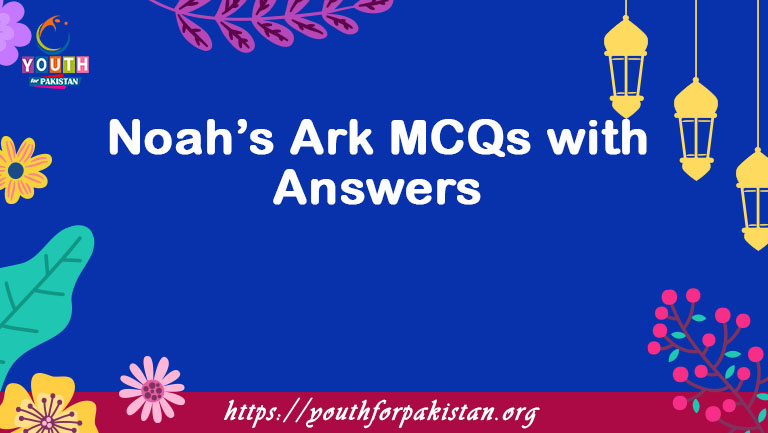The following are Noah’s Ark MCQs with answers related to Islamic Studies. We have arranged the most important and repeated MCQs in all the competitive examinations. The students can clear their concepts for Noah’s Ark MCQs online quiz by attempting these.
Noah’s Ark Online MCQs with Answers
Who is considered the prophet and builder of Noah’s Ark in the biblical and Quranic accounts?
a) Abraham
b) Noah
c) Jonah
d) David
In Islamic tradition, who is known as Nuh (peace be upon him)?
a) Jonah
b) Solomon
c) Noah
d) David
What is the primary reason cited in the Quran for the construction of Noah’s Ark?
a) To explore the oceans
b) To escape a plague
c) To rescue believers from a flood
d) To serve as a royal palace
In the Quranic account, what is the significance of the ark built by Noah (Nuh)?
a) It was a symbol of wealth and power.
b) It was a place of worship.
c) It served as a means of salvation from the flood.
d) It had no significance.
According to Islamic tradition, how many years did Noah (Nuh) preach to his people about the coming flood?
a) 40 years
b) 70 years
c) 950 years
d) 1000 years
In the Quranic account, what was the response of Noah’s people to his message and warning of the flood?
a) They believed and repented.
b) They mocked and rejected him.
c) They sought shelter on the Ark.
d) They immediately started building their own arks.
According to Islamic tradition, how did Noah (Nuh) gather the animals onto the Ark?
a) He went into the wilderness and brought them back.
b) God sent the animals to him in pairs.
c) He sent his sons to collect the animals.
d) The animals came on their own in obedience to God’s command.
In the Quranic account, how many of each kind of animal did Noah (Nuh) take onto the Ark?
a) Two of each kind
b) Seven of each kind
c) Ten of each kind
d) One of each kind
According to Islamic tradition, what was the size of Noah’s Ark in terms of length?
a) 100 cubits
b) 300 cubits
c) 500 cubits
d) 700 cubits
In the Quranic account, what material was Noah’s Ark made of?
a) Iron
b) Steel
c) Wood
d) Brick and mortar
According to Islamic tradition, what is the significance of the number seven in the story of Noah’s Ark?
a) It represents the days of the week.
b) It signifies the number of animals on the Ark.
c) It symbolizes completeness and perfection.
d) It has no significance.
In the Quranic account, what did God command Noah (Nuh) to do with the Ark once the floodwaters receded?
a) To dismantle it
b) To bury it
c) To preserve it as a relic
d) To offer it as a gift to a neighboring king
According to Islamic tradition, what was the first land that Noah’s Ark landed on after the flood?
a) Mount Sinai
b) Mount Everest
c) Mount Ararat
d) Mount Olympus
In the Quranic account, how long did the floodwaters persist during Noah’s (Nuh’s) time?
a) 7 days and 7 nights
b) 40 days and 40 nights
c) 100 days and 100 nights
d) 365 days and 365 nights
According to Islamic tradition, who were the first people to disbelieve in Noah’s message and drown in the flood?
a) Noah’s family
b) Noah’s followers
c) Noah’s enemies
d) Noah’s children
In the Quranic account, what was the warning sign given by Noah (Nuh) to his son about the flood?
a) A dark cloud
b) A flood siren
c) A high tower
d) A ship
According to Islamic tradition, why did Noah’s son refuse to board the Ark?
a) He didn’t believe in God.
b) He was too busy with his work.
c) He was afraid of the animals.
d) He thought he could find safety on a mountain.
In the Quranic account, what did Noah (Nuh) say to his son as the floodwaters began to rise?
a) “Stay with your mother.”
b) “Come aboard the Ark.”
c) “Seek refuge on a hill.”
d) “Abandon hope.”
According to Islamic tradition, what lesson is often drawn from the story of Noah’s Ark regarding the consequences of disobedience?
a) Disobedience has no consequences.
b) Disobedience leads to success.
c) Disobedience invites God’s punishment.
d) Disobedience is justified.
In the Quranic account, what was the final fate of those who rejected Noah’s (Nuh’s) message and refused to board the Ark?
a) They survived by swimming.
b) They were saved by other means.
c) They drowned in the flood.
d) They found refuge on a mountain.
According to Islamic tradition, what happened to the disbelievers who drowned in the flood during Noah’s (Nuh’s) time?
a) They were resurrected.
b) They were given a second chance.
c) They were forgiven by God.
d) They faced eternal punishment.
In the Quranic account, what did Noah (Nuh) do when he realized that his son was among the drowning disbelievers?
a) He rejoiced.
b) He prayed for his son’s salvation.
c) He blamed himself.
d) He abandoned the Ark.
According to Islamic tradition, what lesson is often drawn from the story of Noah’s Ark regarding the importance of faith and obedience to God?
a) Faith and obedience are irrelevant.
b) Faith and obedience lead to disaster.
c) Faith and obedience are essential for salvation.
d) Faith and obedience are signs of arrogance.
In the Quranic account, what is the significance of the dove sent by Noah (Nuh) from the Ark?
a) It was a messenger to his people.
b) It was a symbol of peace and hope.
c) It was a sign of God’s anger.
d) It had no significance.
According to Islamic tradition, what did the dove bring back to Noah (Nuh) as a sign that the floodwaters were receding?
a) An olive branch
b) A piece of bread
c) A feather
d) A fish
In the Quranic account, what did God promise to Noah (Nuh) after the flood?
a) Wealth and prosperity
b) Eternal life
c) Divine protection
d) A new world order
According to Islamic tradition, how many people were saved on Noah’s Ark, including Noah and his family?
a) 7
b) 12
c) 40
d) 72
In the Quranic account, what message did Noah (Nuh) convey to his people as he called them to faith?
a) “Worship idols.”
b) “Obey me without question.”
c) “There is no deity but God.”
d) “Follow your desires.”
According to Islamic tradition, what is the lesson often drawn from the story of Noah’s Ark regarding the importance of patience in delivering God’s message?
a) Patience is irrelevant.
b) Patience leads to failure.
c) Patience is essential for prophets.
d) Patience leads to arrogance.
In the Quranic account, what is the fate of the disbelievers who rejected Noah’s (Nuh’s) message and drowned in the flood?
a) They were resurrected and forgiven.
b) They were given a second chance.
c) They were rewarded with paradise.
d) They faced eternal punishment.
According to Islamic tradition, what is the significance of the flood in the story of Noah’s Ark regarding God’s judgment and mercy?
a) The flood represents God’s mercy.
b) The flood signifies God’s forgiveness.
c) The flood illustrates God’s judgment and mercy.
d) The flood has no significance.
In the Quranic account, how did Noah (Nuh) address God after the floodwaters receded and the Ark landed on Mount Judi?
a) “You are the All-Powerful.”
b) “I am victorious.”
c) “I am the king of the world.”
d) “Glory be to God.”
According to Islamic tradition, what lesson is often drawn from the story of Noah’s Ark regarding the importance of trust in God’s plan?
a) Trust in God’s plan is discouraged.
b) Trust in God’s plan leads to failure.
c) Trust in God’s plan is essential for believers.
d) Trust in God’s plan leads to arrogance.
In the Quranic account, what did Noah (Nuh) and his family find on the Ark to sustain them during their journey?
a) A map to the Promised Land
b) Guidance through a divine cloud
c) Manna and quails for sustenance
d) An abundance of water from springs
According to Islamic tradition, what is the significance of Noah’s staff in his mission?
a) It was a symbol of his authority.
b) It was used for hunting.
c) It had the power to heal.
d) It could control the weather.
In the Quranic account, what role did Noah’s son play in his mission?
a) He was the leader of the people.
b) He was a prophet sent alongside Noah.
c) He served as a mediator between Noah and the disbelievers.
d) He rejected his father’s message.
According to Islamic tradition, what is the lesson often drawn from the story of the flood regarding the consequences of disbelief?
a) Disbelief has no consequences.
b) Disbelief leads to prosperity.
c) Disbelief invites God’s punishment.
d) Disbelief is justified.
In the Quranic account, what was the primary purpose of Noah’s mission to his people?
a) To build a great civilization
b) To gather wealth and power
c) To warn them of the impending flood and call them to faith
d) To conquer neighboring lands
According to Islamic tradition, what is the lesson often drawn from the story of the flood regarding the importance of humility and repentance?
a) Humility and repentance are discouraged.
b) Humility and repentance are signs of weakness.
c) Humility and repentance are essential for believers.
d) Humility and repentance lead to arrogance.
In the Quranic account, what did God use to guide Noah and his followers during their journey on the Ark?
a) A divine cloud
b) A network of underground tunnels
c) A celestial map
d) A guiding star
According to Islamic tradition, what is the lesson often drawn from the story of Noah’s determination to save his people from the flood?
a) Efforts to save others are futile.
b) Efforts to save others lead to chaos.
c) Efforts to save others are essential for prophets.
d) Efforts to save others are a form of rebellion.
In the Quranic account, what did the disbelievers do when they saw the flood approaching?
a) They repented and sought forgiveness.
b) They sought refuge on the Ark.
c) They mocked Noah and his followers.
d) They built their own arks.
According to Islamic tradition, what is the lesson often drawn from the story of Noah’s reliance on God during the flood?
a) Reliance on God is discouraged.
b) Reliance on God is a sign of weakness.
c) Reliance on God is essential for believers.
d) Reliance on God leads to arrogance.
In the Quranic account, what is the significance of the covenant made between Noah and God after the flood?
a) It has no significance.
b) It signifies God’s mercy.
c) It serves as a legal contract.
d) It symbolizes God’s anger.
According to Islamic tradition, what is the lesson often drawn from the story of Noah’s Ark regarding the importance of gratitude and thankfulness?
a) Gratitude and thankfulness are discouraged.
b) Gratitude and thankfulness are unnecessary.
c) Gratitude and thankfulness are essential for believers.
d) Gratitude and thankfulness lead to arrogance.
In the Quranic account, what did Noah (Nuh) and his followers find on the Ark to sustain them during their journey?
a) A map to the Promised Land
b) Guidance through a divine cloud
c) Manna and quails for sustenance
d) An abundance of water from springs
According to Islamic tradition, what is the lesson often drawn from the story of Noah’s Ark regarding the importance of perseverance in the face of adversity?
a) Perseverance is discouraged.
b) Perseverance leads to failure.
c) Perseverance is essential for believers.
d) Perseverance leads to arrogance.
In the Quranic account, what did God use to guide Noah and his followers in the wilderness?
a) A divine cloud
b) A flock of birds
c) A network of underground tunnels
d) A celestial map
According to Islamic tradition, what is the lesson often drawn from the story of Noah’s Ark regarding the importance of hope and trust in God’s promises?
a) Hope and trust in God’s promises are discouraged.
b) Hope and trust in God’s promises lead to disappointment.
c) Hope and trust in God’s promises are essential for believers.
d) Hope and trust in God’s promises lead to arrogance.
In the Quranic account, what was the ultimate outcome of Noah’s mission to warn his people of the flood?
a) His people believed and repented.
b) His people rejected him, and most of them drowned.
c) His people built their own arks and were saved.
d) His people remained unaffected by the flood.










